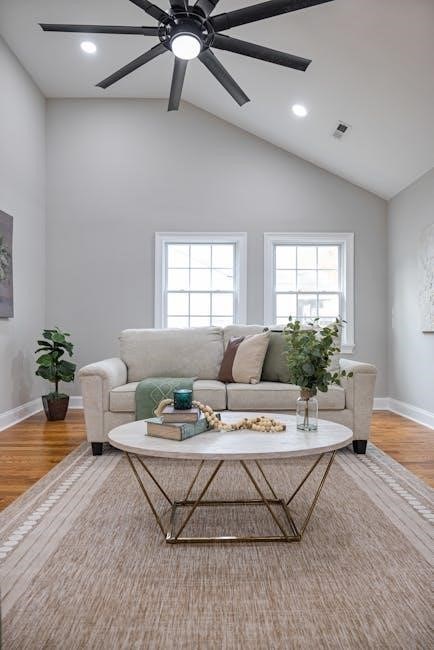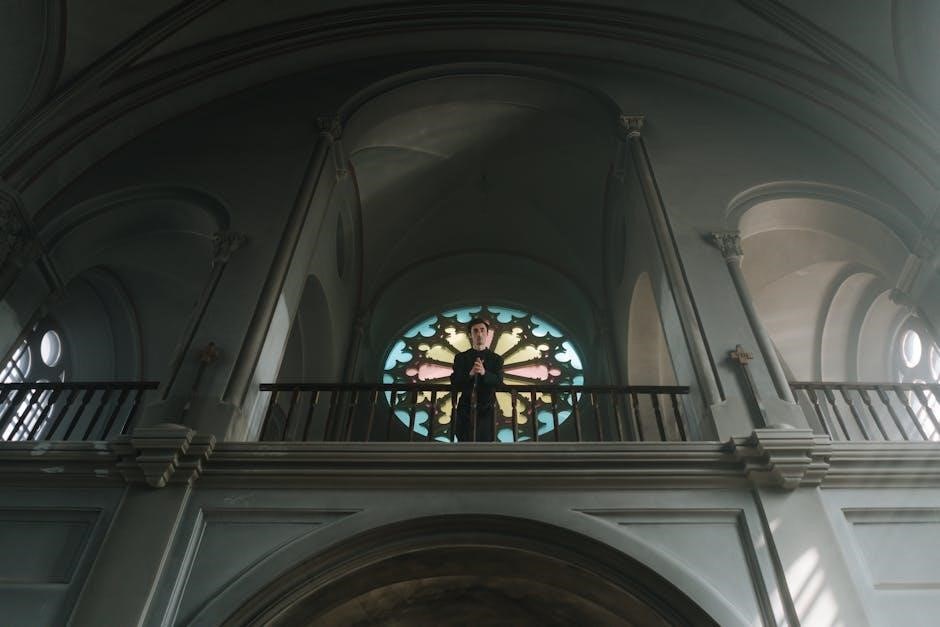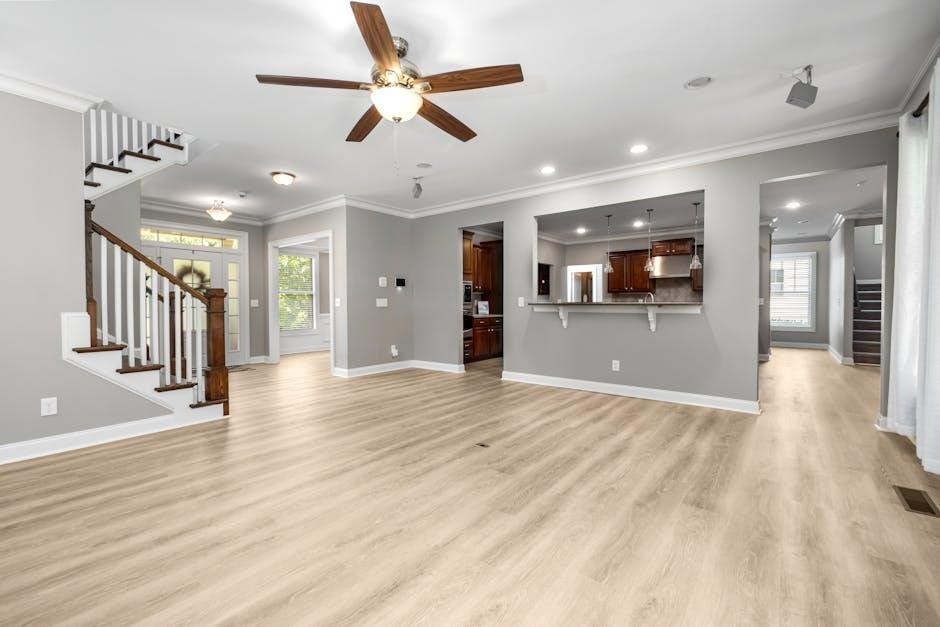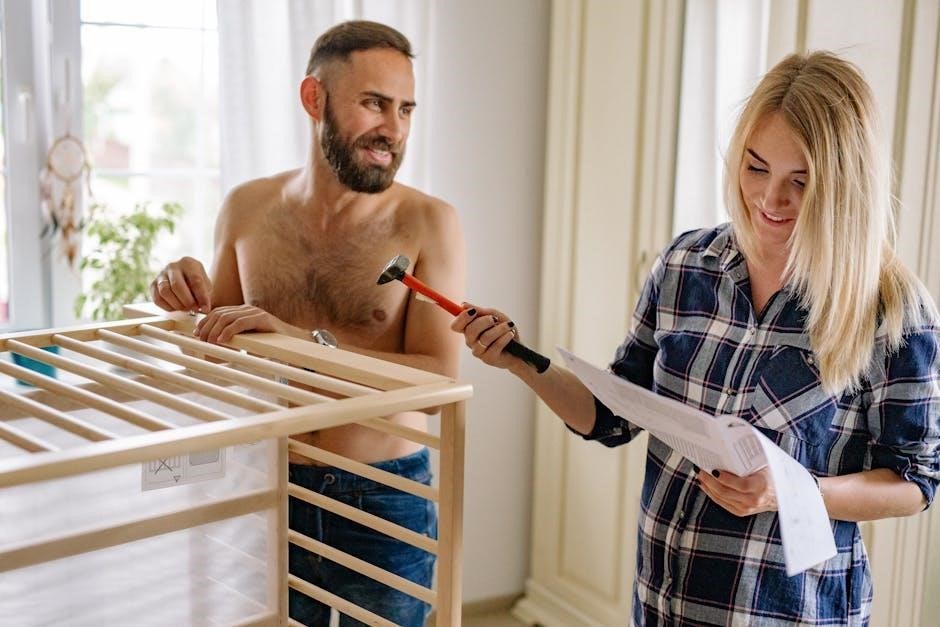Hunter ceiling fan assembly requires careful attention to detail․ Begin by unpacking all components and verifying their presence against the parts list․ Consult your specific model’s manual for detailed diagrams and step-by-step guidance․ Proper assembly ensures safe and efficient operation of your Hunter ceiling fan․
Identifying Your Hunter Ceiling Fan Model
Identifying your Hunter ceiling fan model is crucial for accessing the correct assembly instructions, replacement parts, and troubleshooting guides․ Hunter offers a wide array of ceiling fan models, each with unique features and specific installation requirements․ Locating the model number typically involves checking several places on the fan itself, the original packaging, or the owner’s manual․
The most common location for the model number is on a sticker affixed to the motor housing of the fan․ This sticker may also include the fan’s serial number and manufacturing date․ Another place to check is the top of the fan motor, concealed by the canopy that attaches to the ceiling․ If you still cannot locate the model number on the fan, refer to the original packaging or the owner’s manual that came with the fan․ The model number is usually prominently displayed on the box or the cover of the manual․
Online resources, such as the Hunter Fan website, offer searchable databases where you can input known information, such as design characteristics or features, to narrow down potential matches․ Once you have identified the model number, you can access detailed assembly instructions, parts diagrams, and troubleshooting information specific to your Hunter ceiling fan․
Essential Tools and Materials Required
Before embarking on the assembly of your Hunter ceiling fan, gathering the essential tools and materials is paramount for a smooth and safe installation process․ Having everything readily available will minimize interruptions and ensure you can complete the task efficiently․ This preparation is a critical step for both experienced DIYers and first-time installers․
First and foremost, you will need a sturdy ladder or step stool to safely reach the ceiling and work on the electrical connections․ A Phillips head screwdriver and a flathead screwdriver are indispensable for tightening screws and making wiring connections․ A wire stripper and cutter are essential for preparing the wires for connection, ensuring a secure and reliable electrical circuit․ Electrical tape is also necessary for insulating wire connections and preventing short circuits․
A voltage tester is crucial for verifying that the power is turned off before working on any electrical components․ Additionally, you will need the mounting hardware that comes with your Hunter ceiling fan, including screws, brackets, and wire connectors․ Depending on your specific installation, you may also need a drill with various drill bits for creating pilot holes, as well as a stud finder to locate ceiling joists for secure mounting․ Finally, safety glasses and work gloves will protect your eyes and hands during the assembly process․
Safety Precautions Before Installation
Prioritizing safety is paramount before commencing any electrical work, including the installation of your Hunter ceiling fan․ Taking the necessary precautions will protect you from potential hazards and ensure a safe and successful installation․ Neglecting these steps can lead to serious injuries or damage to your property․
The first and most crucial step is to disconnect the power supply to the circuit at the breaker box or fuse box․ This will prevent electrical shock during the installation process․ Always double-check that the power is off using a voltage tester before touching any wires․ Never assume that the power is off just because you flipped a switch․
Wear safety glasses to protect your eyes from falling debris or wire clippings․ Use work gloves to protect your hands from sharp edges and electrical burns․ Ensure that your ladder or step stool is stable and placed on a level surface to prevent falls․ If you are not comfortable working with electricity, consider hiring a qualified electrician to perform the installation․ Familiarize yourself with the Hunter ceiling fan’s installation manual and follow all instructions carefully․ Ignoring these safety precautions can have serious consequences․
Mounting Bracket Installation
The secure installation of the mounting bracket is crucial for the stability and safe operation of your Hunter ceiling fan․ Begin by locating a suitable ceiling joist or a properly rated electrical box designed to support the weight of the fan․ Confirm that the chosen location can handle the fan’s weight․ Failure to do so could cause the fan to fall, resulting in damage or injury․

If a suitable joist is available, attach the mounting bracket directly to the joist using wood screws․ If using an electrical box, ensure it is securely attached to the ceiling structure․ For low-profile installations, attach the bracket using sheet metal screws or wood screws with washers, drilling pilot holes as needed․
Carefully align the mounting bracket with the electrical box or joist, ensuring it is centered and level․ Securely tighten all screws to prevent wobbling or movement․ Double-check the bracket’s stability before proceeding․ The mounting bracket must be flush with the ceiling surface․ Correct installation of the mounting bracket is a prerequisite for a successful and safe Hunter ceiling fan installation․
Wiring Connections: Step-by-Step Guide
Before commencing any wiring, ensure the power supply to the circuit is completely shut off at the breaker box to prevent electrical shock․ Identify the wires from the ceiling: typically black (hot), white (neutral), and green or bare copper (ground)․ Consult your Hunter ceiling fan’s wiring diagram for the correct wire connections․
Connect the corresponding wires from the fan to the ceiling wires using wire connectors․ Securely twist the wires together and tighten the connectors to ensure a firm connection․ The black wire from the fan should connect to the black wire from the ceiling․ The white wire from the fan should connect to the white wire from the ceiling․ The green or bare copper wire from the fan should connect to the ground wire from the ceiling․
If your fan includes a remote receiver, connect it according to the wiring diagram․ Neatly tuck the wires into the electrical box, ensuring no wires are pinched or exposed․ Double-check all connections before restoring power․ Improper wiring can lead to malfunction or electrical hazards․ After checking all connections, carefully restore power to the circuit and test the fan’s operation․
Attaching the Fan Blades
The process of attaching the fan blades to your Hunter ceiling fan involves several steps that require precision and care․ First, identify the fan blade irons or brackets․ These are the metal pieces that connect the blades to the fan motor․ If your fan includes blade grommets, insert them into the holes on the blades․
Next, align each blade with a blade iron and secure them together using the provided blade assembly screws․ Ensure that the screws are tightened firmly, but avoid over-tightening, which could damage the blade or the iron․ Repeat this process for all the fan blades․
Once all the blades are attached to their respective irons, it’s time to attach the blade assemblies to the fan motor housing․ Align the holes on the blade irons with the corresponding mounting points on the motor housing․ Secure each blade assembly with screws, making sure they are snug but not overly tight․ Double-check that all blades are securely attached and evenly spaced for balanced operation․ A wobbling fan can be a sign of improperly attached blades․

Installing the Light Kit (If Applicable)
If your Hunter ceiling fan includes a light kit, carefully follow these instructions for proper installation․ Before you begin, ensure that the fan’s power supply is disconnected at the breaker․ Locate the light kit assembly and identify all its components, referring to your fan’s manual for specific parts․
Typically, the light kit attaches to the bottom of the fan motor housing․ You’ll likely find a set of wires extending from the motor that need to be connected to the light kit’s wiring harness․ Carefully match the wires according to color: black to black, white to white, and ground to ground․ Secure the connections with wire connectors, ensuring a tight and safe bond․
Next, align the light kit with the mounting points on the fan motor housing and attach it using screws․ Some Hunter light kits feature a “turn-and-lock” mechanism for easy installation․ Once the light kit is securely attached, proceed to install the bulbs and the glass shade, following the instructions in the subsequent section․ Remember to consult your fan’s manual for any specific instructions or diagrams related to your model’s light kit․
Installing the Bulbs and Glass Shade
After the light kit is securely installed, it’s time to add the bulbs and glass shade to your Hunter ceiling fan․ First, determine the correct type and wattage of bulbs required for your light kit․ Most new Hunter fans use LED light bulbs due to their durability and energy efficiency․ Refer to your fan’s manual or the light kit itself for the bulb specifications․
Carefully screw the bulbs into the light sockets, ensuring they are snug but not overtightened․ Next, prepare the glass shade for installation․ Depending on the design, the shade may attach with screws, clips, or a twist-and-lock mechanism․ Align the shade with the light kit and secure it according to the instructions․
If screws are used, tighten them evenly to prevent cracking the glass․ For clip-on shades, ensure each clip is properly engaged․ With a twist-and-lock system, gently rotate the shade until it clicks into place․ Once the glass shade is securely attached, double-check its stability before restoring power to the fan․ Your Hunter ceiling fan is now ready to illuminate your space!

Attaching the Pull Chains
The next step in completing your Hunter ceiling fan installation is attaching the pull chains․ These chains control the fan’s speed and the light kit, if applicable․ Locate the pre-drilled holes or connectors on the fan motor housing and the light kit where the chains will be attached․
Typically, the chains have small metal balls or connectors at the end for easy attachment․ Carefully insert the connector through the designated hole and ensure it is securely fastened․ For fans with both fan speed and light control chains, it’s helpful to label them for easy identification․ Small tags or stickers can be used for this purpose․

Once the chains are attached, test them to ensure they function correctly․ Pull each chain to verify that the fan speeds change and the light turns on and off as expected․ If a chain feels stiff or doesn’t operate smoothly, double-check the connection and ensure there are no obstructions․ Adjust the length of the chains to your preference, ensuring they hang within easy reach․ Your Hunter ceiling fan is now ready for operation!
Remote Control Setup and Synchronization
Once your Hunter ceiling fan is physically installed, the final step is setting up and synchronizing the remote control, if your model includes one․ Begin by inserting the batteries into the remote, ensuring they are properly aligned according to the markings in the battery compartment․
Next, locate the synchronization or “learn” button on the fan’s receiver unit, typically found within the canopy or near the motor housing․ Press and hold this button while simultaneously pressing a designated button on the remote, as indicated in your fan’s manual․ This process establishes a connection between the remote and the receiver․
After synchronization, test all the remote’s functions, including fan speed control, light dimming (if applicable), and reverse function․ If any function doesn’t work, repeat the synchronization process․ Some remotes may require setting a specific frequency or code to match the receiver․ Consult your manual for detailed instructions on frequency or code adjustments․ Proper remote setup ensures convenient control of your Hunter ceiling fan․
Troubleshooting Common Issues
Even with careful installation, you might encounter issues with your Hunter ceiling fan․ A common problem is the fan not starting․ Check the power supply, ensuring the circuit breaker is on and the wiring connections are secure․ Also, confirm the remote control batteries are fresh and properly installed․
Another frequent issue is fan wobble․ Ensure all blade screws are tightened and the blades are properly balanced․ Use the balancing kit provided to adjust blade weight if necessary․ Excessive noise can stem from loose screws, motor issues, or blade imbalances; tighten all connections and inspect blades for damage․
If the light kit isn’t working, verify the bulb is correctly installed and not burned out․ Check the wiring connections within the light kit and the fan’s switch housing․ For remote-controlled fans, synchronization problems can arise․ Resynchronize the remote with the receiver by following the instructions provided in the product manual․ If problems persist, consulting Hunter’s customer support or a qualified electrician is recommended․
